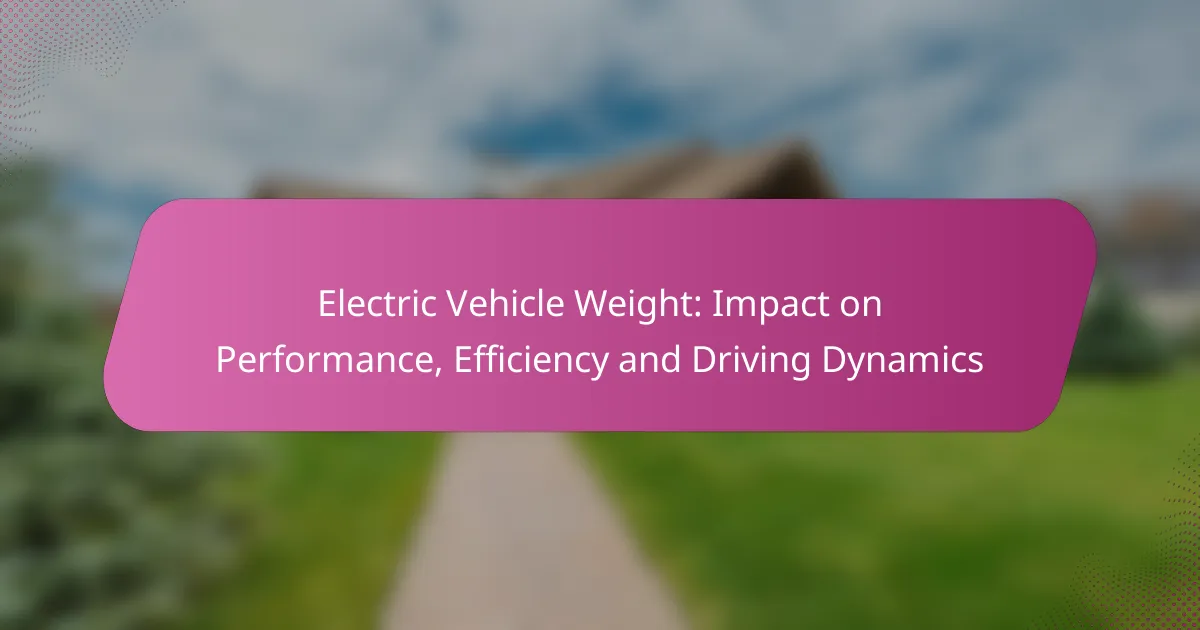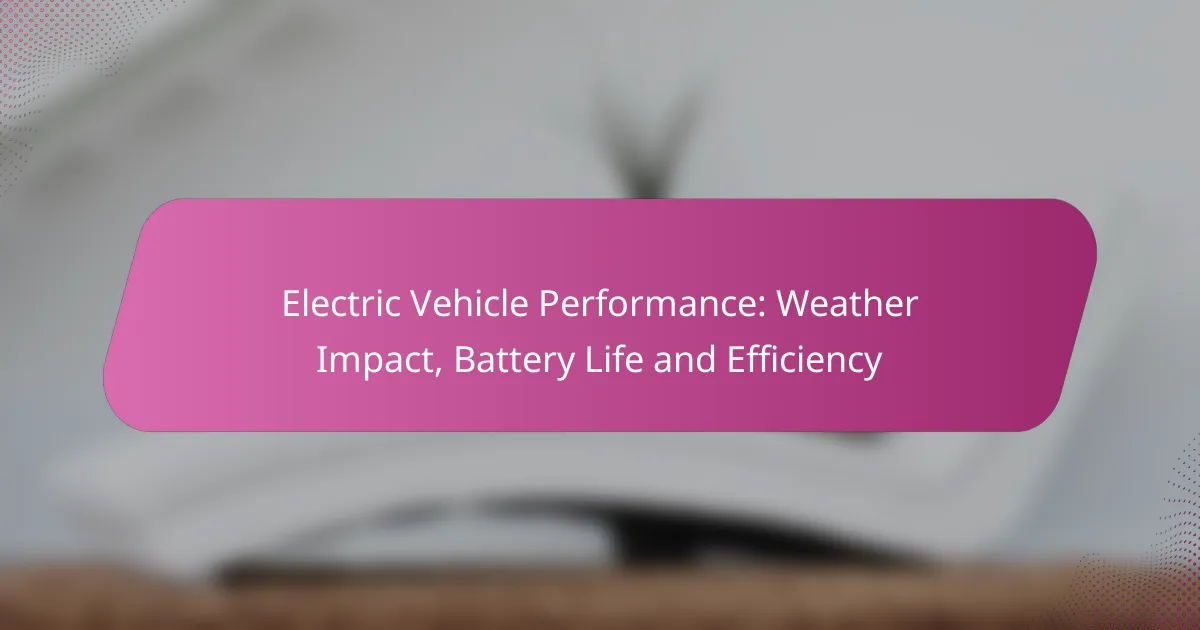The weight of an electric vehicle (EV) plays a crucial role in determining its performance, efficiency, and driving dynamics. Heavier EVs may struggle with acceleration and handling, while lighter models tend to offer improved efficiency and agility. As weight influences energy consumption and overall range, it is a vital consideration in the design and user experience of electric vehicles.
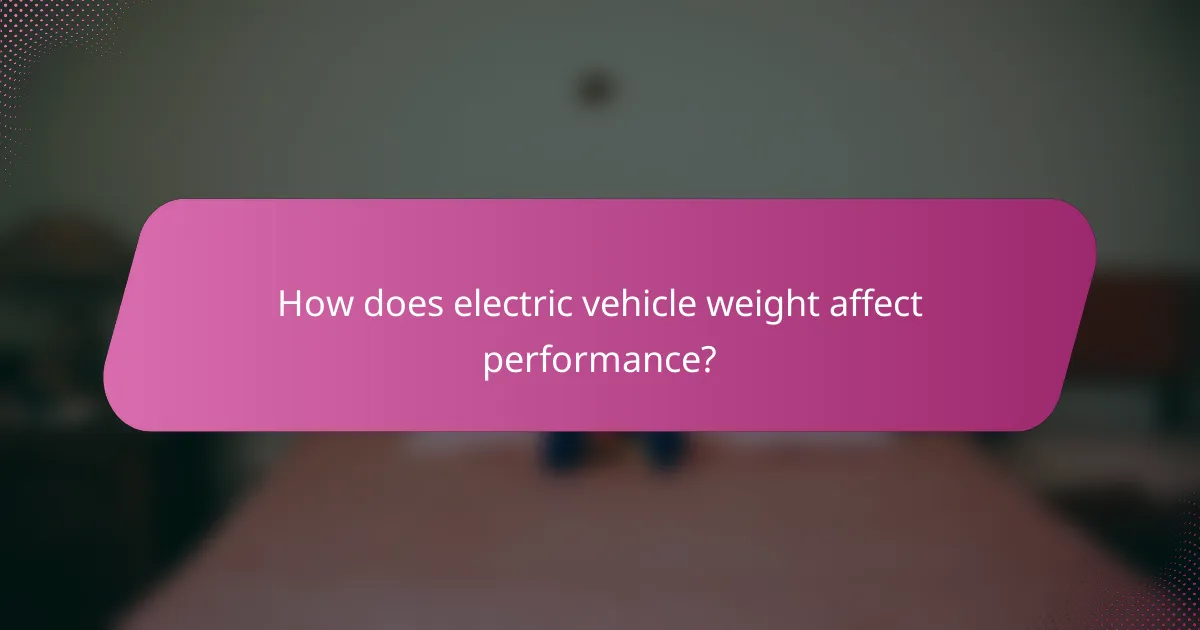
How does electric vehicle weight affect performance?
The weight of an electric vehicle (EV) significantly impacts its overall performance, efficiency, and driving dynamics. Heavier vehicles may experience slower acceleration and reduced handling capabilities, while lighter models often provide better efficiency and agility.
Acceleration impact
Acceleration in electric vehicles is influenced by weight due to the relationship between mass and force. A heavier EV requires more energy to achieve the same acceleration as a lighter counterpart. This can result in longer times to reach common speeds, especially in models with smaller motors.
For example, a compact EV weighing around 1,500 kg may accelerate from 0 to 100 km/h in approximately 7 seconds, while a heavier model at 2,000 kg could take a second or two longer. Thus, potential buyers should consider weight when assessing performance specifications.
Handling characteristics
Weight distribution affects handling and stability in electric vehicles. A lower center of gravity, often achieved by placing batteries in the floor, can enhance cornering performance and reduce body roll. However, excessive weight can lead to sluggish responses and diminished maneuverability.
For instance, an EV with a balanced weight distribution may handle better on winding roads compared to a heavier model that feels cumbersome. Drivers should test vehicles under various conditions to gauge handling and comfort.
Braking efficiency
Braking efficiency in electric vehicles is also affected by weight, as heavier models typically require more force to stop. This can lead to longer stopping distances, particularly in emergency situations. However, many EVs utilize regenerative braking systems that can help mitigate some of this impact by converting kinetic energy back into stored energy.
For example, a heavier EV might have a stopping distance of around 40 meters from 100 km/h, while a lighter model could stop in about 35 meters. Understanding the braking characteristics of a vehicle can be crucial for safety and driving confidence.

What is the relationship between weight and efficiency in electric vehicles?
The weight of electric vehicles (EVs) significantly impacts their efficiency, as heavier vehicles typically require more energy to operate. Increased weight can lead to higher energy consumption rates, reducing overall range and performance.
Energy consumption rates
Energy consumption rates in electric vehicles are influenced by their weight. Heavier vehicles generally consume more kilowatt-hours (kWh) per mile due to the additional energy required to accelerate and maintain speed. For instance, a lightweight EV may achieve energy consumption rates of around 15-20 kWh per 100 miles, while a heavier model could see rates increase to 25-30 kWh or more.
To optimize energy consumption, manufacturers often focus on lightweight materials and efficient designs. Drivers can also enhance efficiency by minimizing additional weight from cargo and accessories.
Range implications
The range of an electric vehicle is directly affected by its weight, as increased weight leads to higher energy consumption, which can shorten the distance the vehicle can travel on a single charge. A typical EV may have a range of 200-300 miles, but heavier models could see this reduced by 10-20% or more, depending on driving conditions and habits.
To maximize range, it’s advisable to keep the vehicle as light as possible and maintain proper tire pressure. Additionally, driving at moderate speeds and avoiding rapid acceleration can help mitigate the impact of weight on range.
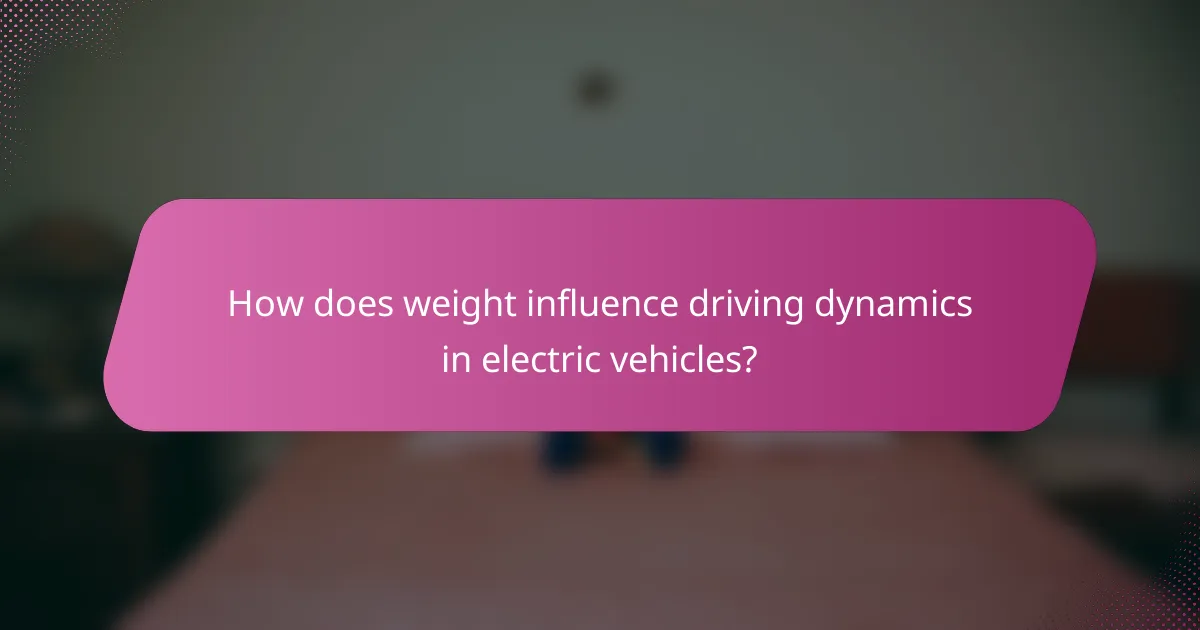
How does weight influence driving dynamics in electric vehicles?
The weight of electric vehicles (EVs) significantly impacts their driving dynamics, affecting stability, handling, and overall performance. Heavier vehicles may offer better traction but can compromise agility and responsiveness, making weight a critical factor in EV design and user experience.
Stability during turns
Weight influences stability during turns by lowering the center of gravity, which can enhance cornering performance. Heavier EVs often exhibit improved grip due to increased tire contact with the road, reducing the likelihood of skidding. However, excessive weight can lead to understeer, where the vehicle fails to turn as sharply as intended.
To optimize stability, manufacturers often distribute weight evenly across the chassis. This balanced weight distribution helps maintain control during sharp turns and enhances driver confidence. Drivers should consider the weight distribution when evaluating an EV’s handling characteristics.
Ride comfort
The weight of an electric vehicle affects ride comfort by influencing how the vehicle absorbs road imperfections. Heavier EVs tend to provide a smoother ride, as their mass helps dampen vibrations and impacts from uneven surfaces. However, if the weight is too high, it can lead to a harsher ride, particularly on rough roads.
To improve ride comfort, manufacturers may use advanced suspension systems that can better manage the weight of the vehicle. Drivers should test drive different models to assess how weight impacts comfort, especially in urban environments where road conditions can vary significantly.
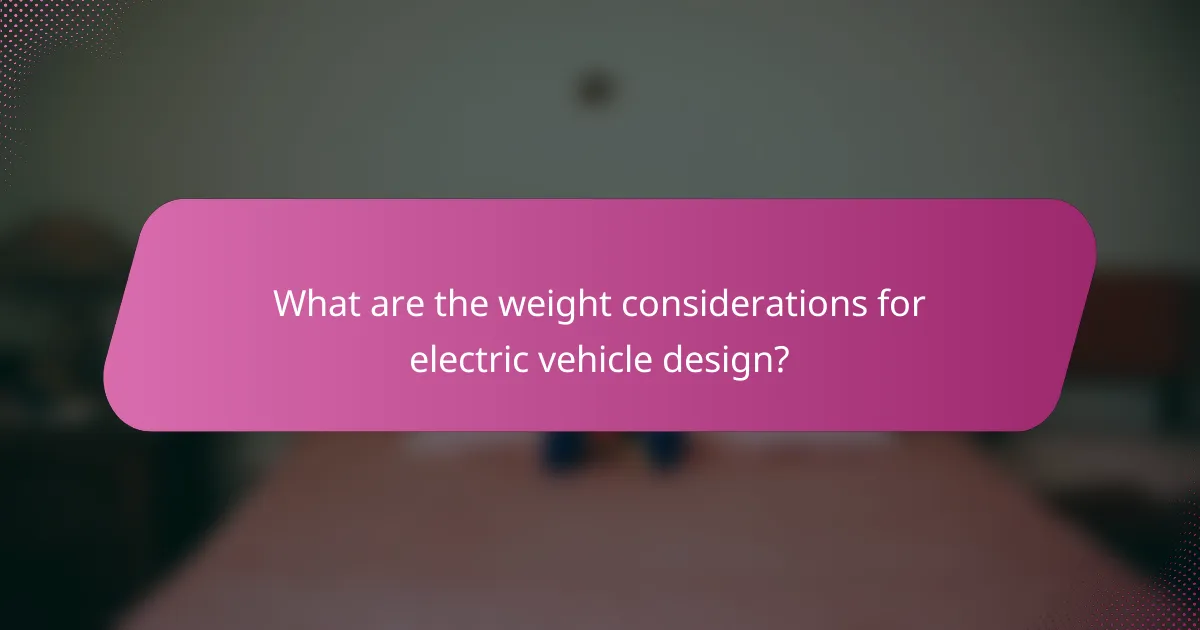
What are the weight considerations for electric vehicle design?
Weight is a critical factor in electric vehicle (EV) design, impacting performance, efficiency, and driving dynamics. Designers must balance the weight of components like batteries and materials to optimize range and handling.
Material choices
Choosing lightweight materials is essential for reducing overall vehicle weight. Common options include aluminum, carbon fiber, and high-strength steel, each offering different benefits in terms of strength, cost, and weight savings. For instance, aluminum can reduce weight by about 30% compared to traditional steel, enhancing efficiency and performance.
However, the cost of materials can vary significantly. While carbon fiber is lighter, it is often much more expensive than aluminum or steel, making it less practical for mass production. Manufacturers must consider the trade-offs between cost, weight, and structural integrity when selecting materials.
Battery placement
The placement of batteries within an electric vehicle significantly affects weight distribution and driving dynamics. Ideally, batteries should be positioned low in the chassis to lower the center of gravity, which improves stability and handling. A well-placed battery can enhance cornering performance and reduce body roll.
Additionally, the weight of the battery pack can influence the design of the vehicle’s suspension system. A heavier battery may require stronger suspension components to maintain ride quality and safety. Manufacturers often conduct simulations and real-world testing to find the optimal battery placement that balances weight, performance, and safety.
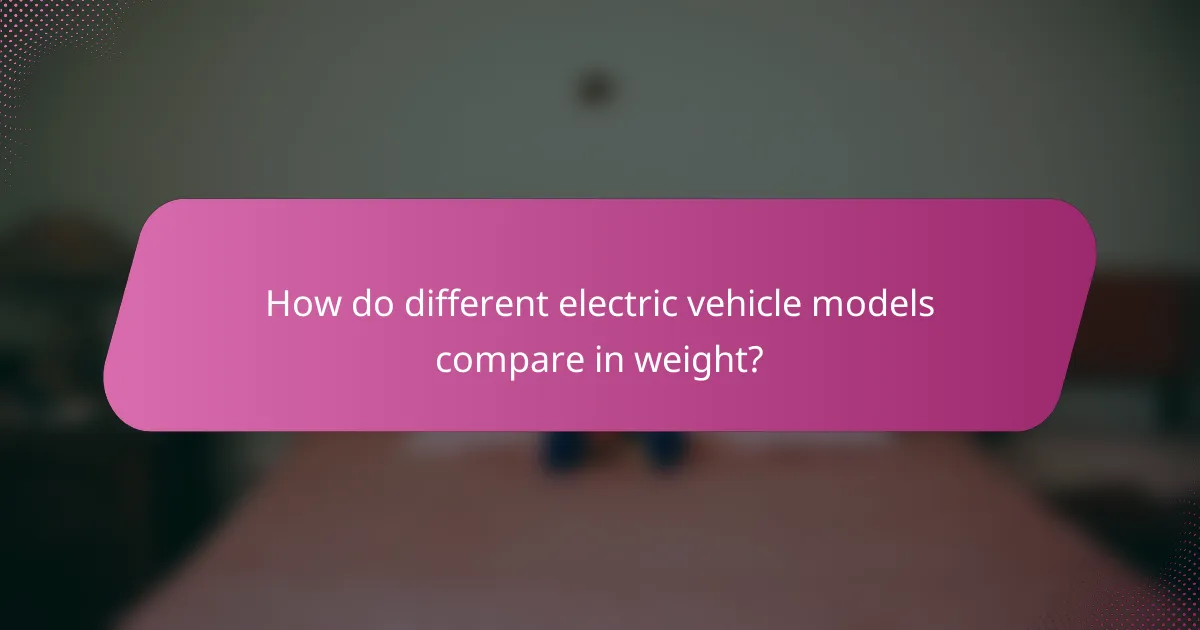
How do different electric vehicle models compare in weight?
Electric vehicle (EV) models vary significantly in weight, which affects their performance, efficiency, and driving dynamics. Generally, lighter models tend to offer better efficiency and handling, while heavier vehicles may provide more stability but can compromise range and acceleration.
Tesla Model 3 weight analysis
The Tesla Model 3 has a weight range of approximately 1,600 to 1,800 kg, depending on the variant and battery size. This weight allows for a balance between performance and efficiency, contributing to its reputation for quick acceleration and decent range.
With a low center of gravity due to the battery placement, the Model 3 enhances driving dynamics, providing a sporty feel while maintaining stability during cornering. The weight distribution also plays a crucial role in braking performance and overall handling.
Nissan Leaf weight comparison
The Nissan Leaf typically weighs between 1,500 and 1,600 kg, making it one of the lighter options in the electric vehicle market. This lower weight contributes to its efficiency, allowing for a respectable range on a single charge.
Despite its lighter build, the Leaf prioritizes comfort and practicality over sporty performance. The weight distribution is designed to provide a smooth ride, although it may not handle as dynamically as heavier models like the Tesla Model 3.

What are the regulations regarding electric vehicle weight?
Regulations on electric vehicle weight vary by country and can impact performance, efficiency, and safety. Understanding these regulations is crucial for manufacturers and consumers alike.
Federal weight limits
In the United States, federal weight limits for vehicles are primarily governed by the Federal Highway Administration (FHWA). The maximum gross vehicle weight rating (GVWR) for passenger vehicles, including electric vehicles, is typically set at 10,000 pounds (approximately 4,536 kg). Exceeding this limit can result in penalties and restrictions on road usage.
For electric vehicles, manufacturers must ensure that the total weight, including the battery and any additional components, complies with these federal standards. This is essential for maintaining safety and performance on public roads.
State-specific regulations
Many states have their own specific regulations regarding electric vehicle weight, which can differ from federal guidelines. For instance, some states may allow higher weight limits for electric vehicles to accommodate the heavier battery systems, often providing exemptions for certain classes of vehicles.
It’s important for electric vehicle owners and manufacturers to research local regulations, as state-specific rules can affect vehicle registration, tolls, and road usage. Checking with the Department of Motor Vehicles (DMV) or local transportation authorities can provide clarity on applicable weight regulations.

How can manufacturers optimize electric vehicle weight?
Manufacturers can optimize electric vehicle weight by using advanced materials and innovative design techniques. Reducing weight enhances performance, efficiency, and driving dynamics, leading to longer ranges and better handling.
Lightweight materials
Utilizing lightweight materials is crucial for reducing the overall weight of electric vehicles. Common materials include aluminum, carbon fiber, and high-strength steel, which offer strength without excessive mass. For instance, aluminum can reduce weight by up to 50% compared to traditional steel components.
Manufacturers should consider the cost-effectiveness of these materials, as some, like carbon fiber, can be significantly more expensive. Balancing performance gains with budget constraints is essential for mass production.
Design innovations
Innovative design techniques play a vital role in minimizing weight while maintaining structural integrity. Techniques such as modular design and optimized aerodynamics can lead to significant reductions in weight. For example, integrating battery packs into the vehicle’s structure can save space and reduce the need for additional support structures.
Additionally, employing computer-aided design (CAD) tools allows engineers to simulate and analyze weight distribution, leading to smarter design choices. Manufacturers should focus on iterative testing and refinement to achieve optimal weight without compromising safety or performance.

What are the future trends in electric vehicle weight management?
Future trends in electric vehicle (EV) weight management focus on reducing overall vehicle mass while maintaining performance and safety. Innovations in materials and battery technology are key to achieving lighter designs, which can enhance efficiency and driving dynamics.
Advancements in battery technology
Battery technology is evolving rapidly, with manufacturers exploring lighter materials and more efficient designs. Solid-state batteries, for instance, promise to reduce weight significantly compared to traditional lithium-ion batteries while offering higher energy density and improved safety.
Additionally, the integration of lightweight materials, such as aluminum and carbon fiber, in battery construction can further decrease overall vehicle weight. This shift not only enhances the range of EVs but also improves acceleration and handling characteristics.
As battery technology advances, manufacturers are likely to adopt modular designs that allow for easier upgrades and replacements, contributing to longer vehicle lifespans and better performance over time.
